Abstract
Peripheral nerve function has been studied in 50 patients with chronic liver disease. An increase in the latency or a reduction in the response amplitude of the evoked sensory potential of the median nerve was detected in 34 of the 50 subjects. This was in striking contrast to the paucity of neurological signs and symptoms suggestive of peripheral nerve damage seen in these patients. There was no evidence to show that alcohol was responsible for the neuropathy. Abnormalities in the excitability changes of sensory nerve during ischaemia were detected in seven of the 16 subjects whose distal sensory latencies were within normal limits. A critical evaluation of the hypotheses which have been postulated to account for the increased resistance of peripheral nerve to inactivation by ischaemia has been made. It is concluded that an increase of the permeability of the periaxonal diffusion barrier to K offers the most acceptable explanation for this phenomenon.
Full text
PDF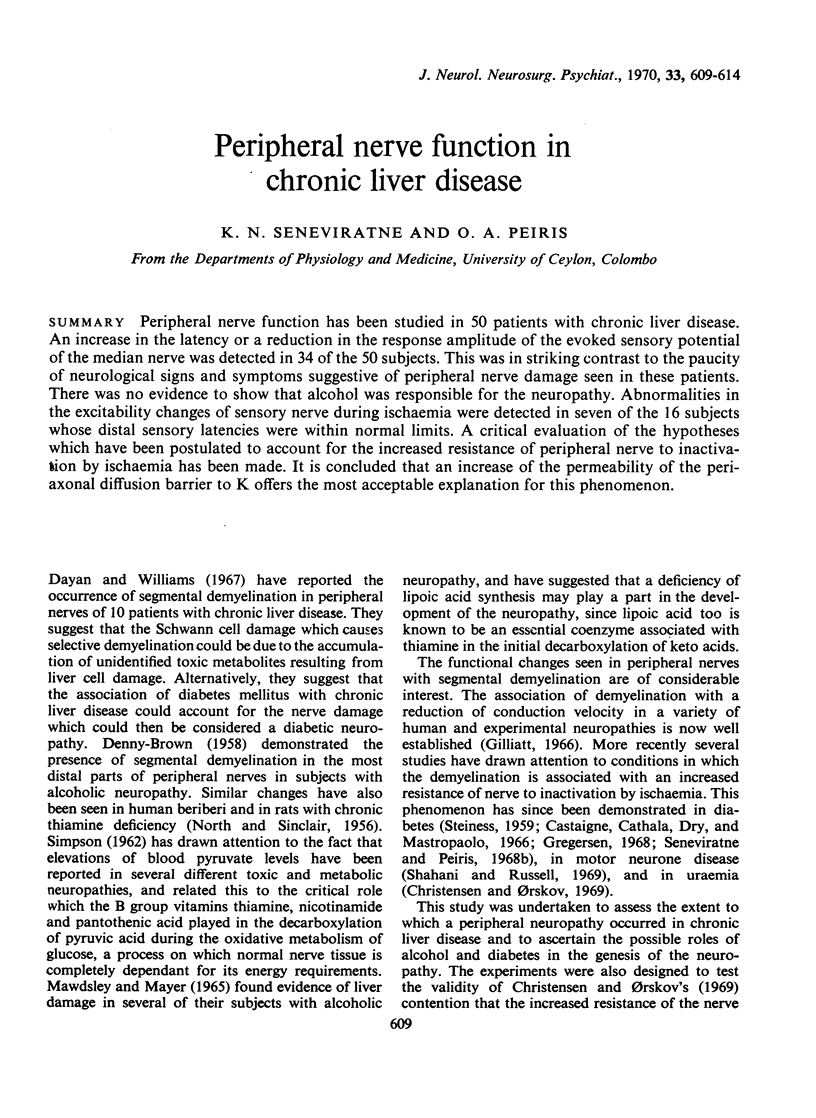

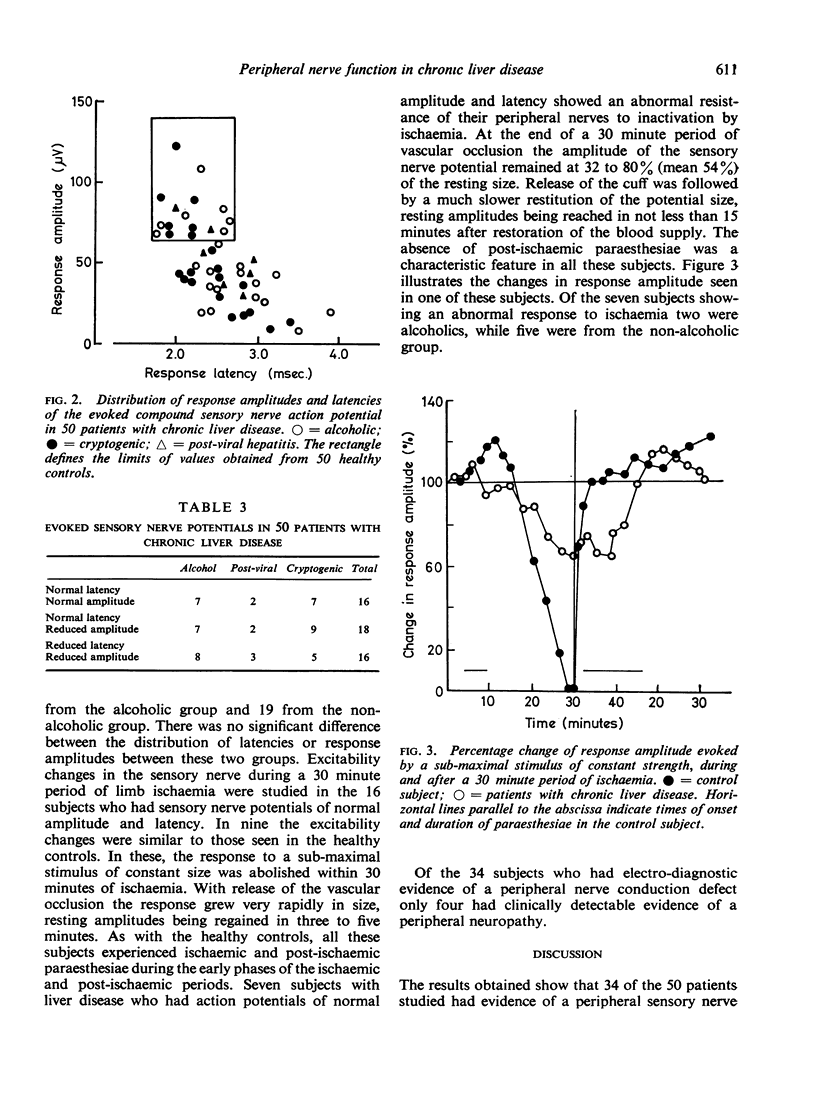
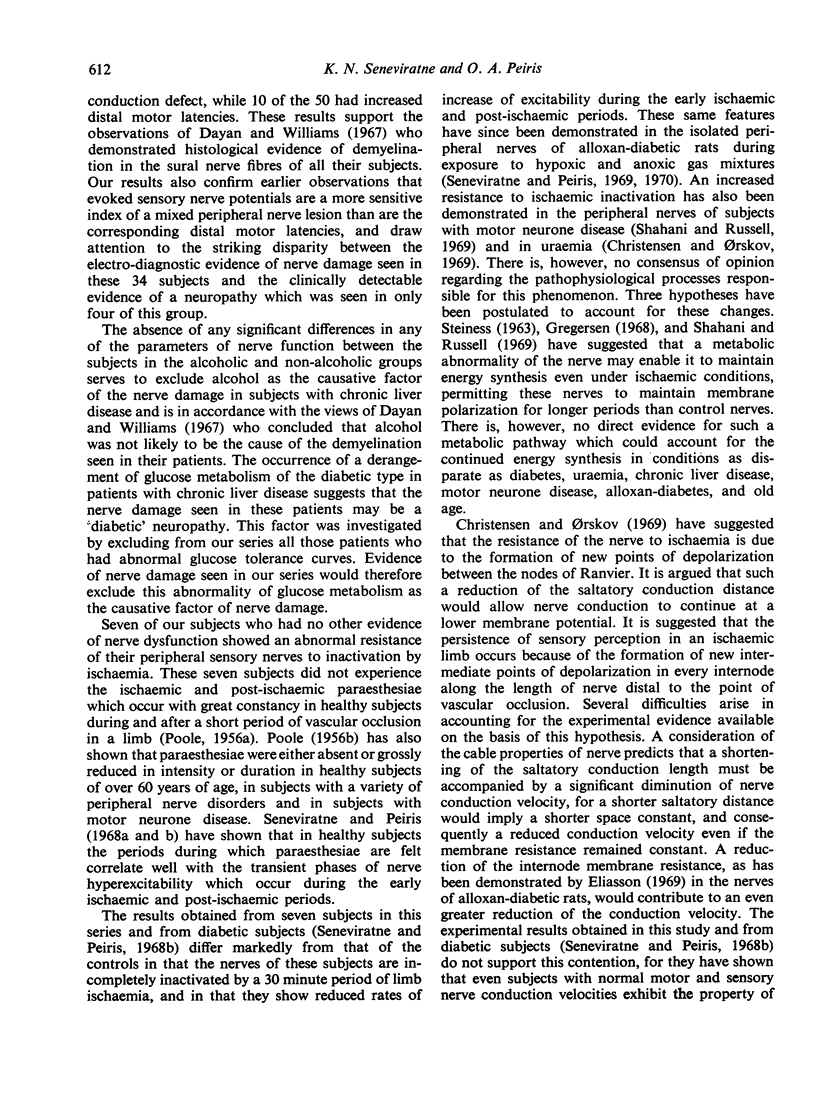
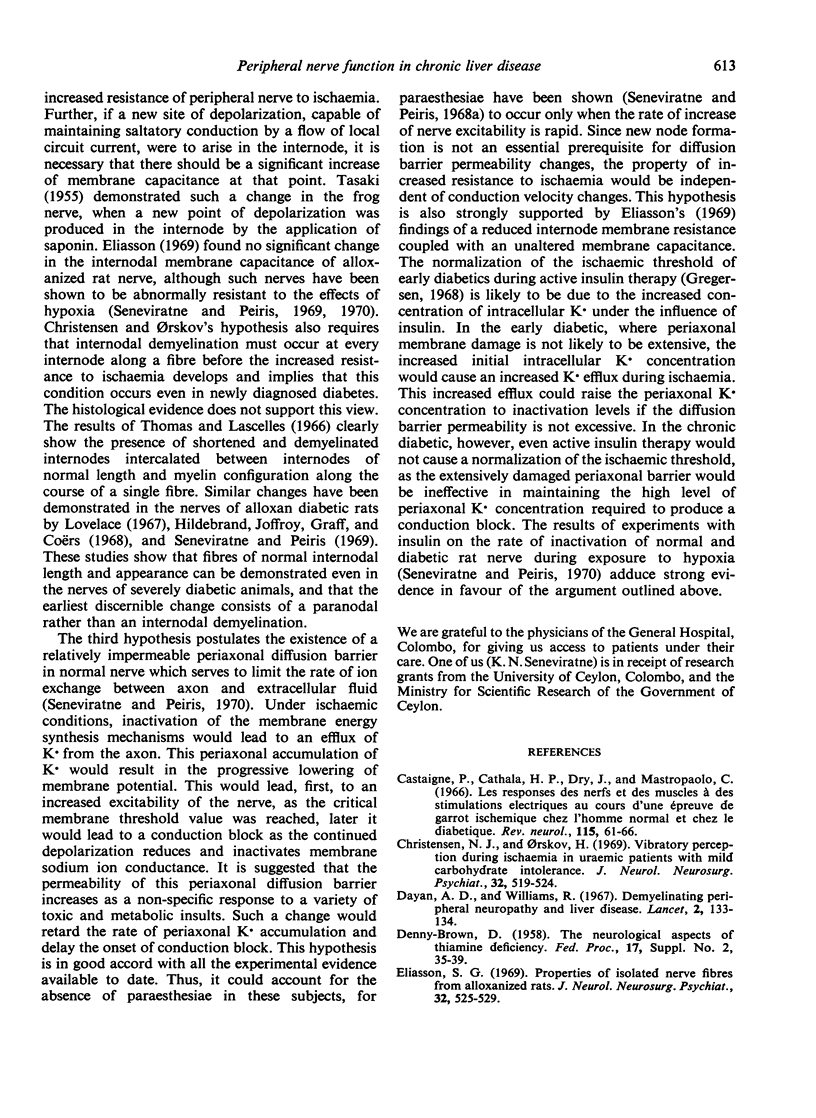
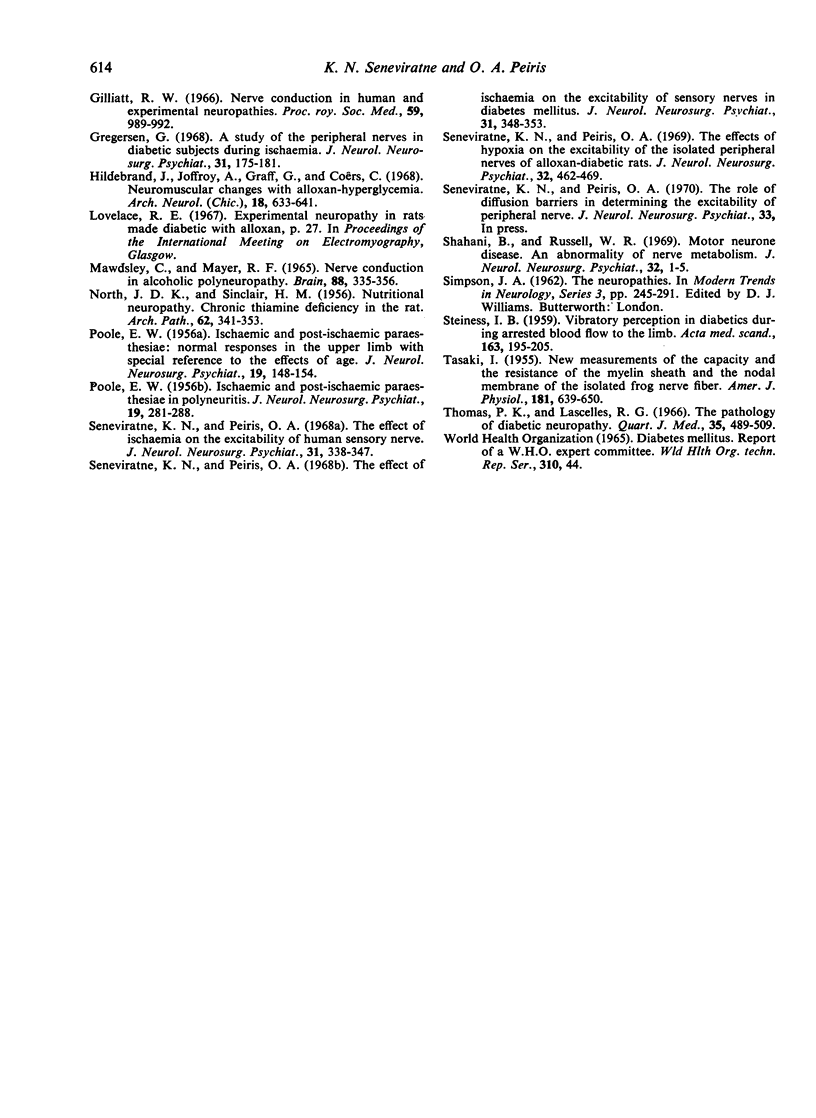
Selected References
These references are in PubMed. This may not be the complete list of references from this article.
- Castaigne P., Cathala H. P., Dry J., Mastropaolo C. Les réponses der nerfs et des muscles à des stimulations électriques AU COURS D'une epreuve de garrot ischémique chez l'homme normal et chez le diabétique. Rev Neurol (Paris) 1966 Jul;115(1):61–66. [PubMed] [Google Scholar]
- Christensen N. J., Orskov H. Vibratory perception during ischaemia in uraemic patients and in subjects with mild carbohydrate intolerance. J Neurol Neurosurg Psychiatry. 1969 Dec;32(6):519–524. doi: 10.1136/jnnp.32.6.519. [DOI] [PMC free article] [PubMed] [Google Scholar]
- Dayan A. D., Williams R. Demyelinating peripheral neuropathy and liver disease. Lancet. 1967 Jul 15;2(7507):133–134. doi: 10.1016/s0140-6736(67)92967-4. [DOI] [PubMed] [Google Scholar]
- Eliasson S. G. Properties of isolated nerve fibres from alloxanized rats. J Neurol Neurosurg Psychiatry. 1969 Dec;32(6):525–529. doi: 10.1136/jnnp.32.6.525. [DOI] [PMC free article] [PubMed] [Google Scholar]
- Gilliatt R. W. Applied electrophysiology in nerve and muscle disease [abridged]. Proc R Soc Med. 1966 Oct;59(10):989–993. [PMC free article] [PubMed] [Google Scholar]
- Gregersen G. A study of the peripheral nerves in diabetic subjects during ischaemia. J Neurol Neurosurg Psychiatry. 1968 Apr;31(2):175–181. doi: 10.1136/jnnp.31.2.175. [DOI] [PMC free article] [PubMed] [Google Scholar]
- Hildebrand J., Joffroy A., Graff G., Coërs C. Neuromuscular changes with alloxan hyperglycemia. Electrophysiological, biochemical, and histological study in rats. Arch Neurol. 1968 Jun;18(6):633–641. doi: 10.1001/archneur.1968.00470360055005. [DOI] [PubMed] [Google Scholar]
- Mawdsley C., Mayer R. F. Nerve conduction in alcoholic polyneuropathy. Brain. 1965 Jun;88(2):335–356. doi: 10.1093/brain/88.2.335. [DOI] [PubMed] [Google Scholar]
- NORTH J. D., SINCLAIR H. M. Nutritional neuropathy; chronic thiamine deficiency in the rat. AMA Arch Pathol. 1956 Nov;62(5):341–353. [PubMed] [Google Scholar]
- POOLE E. W. Ischaemic and post-ischaemic paraesthesiae; normal responses in the upper limb with special reference to the effect of age. J Neurol Neurosurg Psychiatry. 1956 May;19(2):148–154. doi: 10.1136/jnnp.19.2.148. [DOI] [PMC free article] [PubMed] [Google Scholar]
- POOLE E. W. Ischaemic and postischaemic paraesthesiae in polyneuritis. J Neurol Neurosurg Psychiatry. 1956 Nov;19(4):281–288. doi: 10.1136/jnnp.19.4.281. [DOI] [PMC free article] [PubMed] [Google Scholar]
- STEINESS I. Vibratory perception in diabetics during arrested blood flow to the limb. Acta Med Scand. 1959 Mar 4;163(3):195–205. doi: 10.1111/j.0954-6820.1959.tb10400.x. [DOI] [PubMed] [Google Scholar]
- Seneviratne K. N., Peiris O. A. The effect of ischaemia on the excitability of human sensory nerve. J Neurol Neurosurg Psychiatry. 1968 Aug;31(4):338–347. doi: 10.1136/jnnp.31.4.338. [DOI] [PMC free article] [PubMed] [Google Scholar]
- Seneviratne K. N., Peiris O. A. The effect of ischaemia on the excitability of sensory nerves in diabetes mellitus. J Neurol Neurosurg Psychiatry. 1968 Aug;31(4):348–353. doi: 10.1136/jnnp.31.4.348. [DOI] [PMC free article] [PubMed] [Google Scholar]
- Seneviratne K. N., Peiris O. A. The effects of hypoxia on the excitability of the isolated peripheral nerves of alloxan-diabetic rats. J Neurol Neurosurg Psychiatry. 1969 Oct;32(5):462–469. doi: 10.1136/jnnp.32.5.462. [DOI] [PMC free article] [PubMed] [Google Scholar]
- Shahani B., Russell W. R. Motor neurone disease. An abnormality of nerve metabolism. J Neurol Neurosurg Psychiatry. 1969 Feb;32(1):1–5. doi: 10.1136/jnnp.32.1.1. [DOI] [PMC free article] [PubMed] [Google Scholar]
- TASAKI I. New measurements of the capacity and the resistance of the myelin sheath and the nodal membrane of the isolated frog nerve fiber. Am J Physiol. 1955 Jun;181(3):639–650. doi: 10.1152/ajplegacy.1955.181.3.639. [DOI] [PubMed] [Google Scholar]


